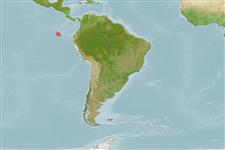Actinopterygii (ray-finned fishes) >
Ophidiiformes (Cusk eels) >
Ophidiidae (Cusk-eels) > Brotulinae
Etymology: Brotula: Latin, brotula, -ae = little, bud, shoot (Ref. 45335). More on author: Hildebrand.
Environment / Climate / Range
Ecology
Marine; reef-associated. Tropical, preferred ?
Distribution
Countries | FAO areas | Ecosystems | Occurrences | Point map | Introductions | Faunafri
Southeast Pacific: Galapagos Islands and Peru.
Size / Weight / Age
Maturity: Lm ? range ? - ? cm
Max length : 75.0 cm TL male/unsexed; (Ref. 34024); common length : 50.0 cm TL male/unsexed; (Ref. 55763)
Inhabit caves and crevices of rocky reefs (Ref. 11482). Oviparous, with oval pelagic eggs floating in a gelatinous mass (Ref. 205). Grow to at least 10 cm (Ref. 11482); size of Brotula species is given as 'at least 75 cm' in Ref. 34024, which is followed here until better information becomes available (RF).
Life cycle and mating behavior
Maturity | Reproduction | Spawning | Eggs | Fecundity | Larvae
Nielsen, J.G., D.M. Cohen, D.F. Markle and C.R. Robins, 1999. Ophidiiform fishes of the world (Order Ophidiiformes). An annotated and illustrated catalogue of pearlfishes, cusk-eels, brotulas and other ophidiiform fishes known to date. FAO Fish. Synop. 125(18):178p. Rome: FAO. (Ref. 34024)
IUCN Red List Status (Ref. 115185)
CITES (Ref. 94142)
Not Evaluated
Threat to humans
Harmless
Human uses
More information
CountriesFAO areasEcosystemsOccurrencesIntroductionsStocksEcologyDietFood itemsFood consumptionRation
Age/Size
Growth
Length-weight
Length-length
Length-frequencies
Morphometrics
Morphology
Larvae
Larval dynamics
Recruitment
Abundance
ReferencesAquacultureAquaculture profileStrainsGeneticsAllele frequenciesHeritabilityDiseasesProcessingMass conversion
Tools
Special reports
Download XML
Internet sources
